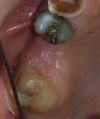Management of oroantral communication using buccal advanced flap
- PMID: 31819785
- PMCID: PMC6884724
- DOI: 10.11604/pamj.2019.34.69.19959
Management of oroantral communication using buccal advanced flap
Abstract
Oroantral communication (OAC) or fistula (OAF) is an open pathological communication between the oral cavity and maxillary sinus which mostly occurs as a result of extraction of upper molars and premolars, iatrogenic complications or from dental infections, osteomyelitis, radiation therapy or trauma. Several alternative techniques modalities have been described throughout the years for the management of OAC and OAF which show both advantages and limitations. The most employed surgical flaps are of three types: advanced buccal flap, palatal flap and buccal fat pad flap. The authors present two clinical cases: oroantral communication and oroantral fistula, both were treated by using buccal advancement flap.
Keywords: Oroantral fistula; buccal advancement flap; maxillary sinus; oroantral communication.
© Akram Belmehdi et al.
Conflict of interest statement
The authors declare no competing interests.
Figures







Similar articles
-
Management of oroantral fistula with displacement of the root into sinus using buccal fat pad: a case report.Pan Afr Med J. 2022 Feb 1;41:85. doi: 10.11604/pamj.2022.41.85.31368. eCollection 2022. Pan Afr Med J. 2022. PMID: 35432700 Free PMC article.
-
Surgical options in oroantral fistula treatment.Open Dent J. 2012;6:94-8. doi: 10.2174/1874210601206010094. Epub 2012 Jun 1. Open Dent J. 2012. PMID: 22715347 Free PMC article.
-
A pedicled buccal periosteal flap for the closure of oro-antral fistula.BMC Oral Health. 2024 Apr 10;24(1):440. doi: 10.1186/s12903-024-04217-6. BMC Oral Health. 2024. PMID: 38600501 Free PMC article.
-
Closure of oroantral fistula: a review of local flap techniques.J Korean Assoc Oral Maxillofac Surg. 2020 Feb;46(1):58-65. doi: 10.5125/jkaoms.2020.46.1.58. Epub 2020 Feb 26. J Korean Assoc Oral Maxillofac Surg. 2020. PMID: 32158682 Free PMC article. Review.
-
The Treatment and Management of Oroantral Communications and Fistulas: A Systematic Review and Network Metanalysis.Dent J (Basel). 2024 May 20;12(5):147. doi: 10.3390/dj12050147. Dent J (Basel). 2024. PMID: 38786545 Free PMC article. Review.
Cited by
-
Management of oroantral fistula with displacement of the root into sinus using buccal fat pad: a case report.Pan Afr Med J. 2022 Feb 1;41:85. doi: 10.11604/pamj.2022.41.85.31368. eCollection 2022. Pan Afr Med J. 2022. PMID: 35432700 Free PMC article.
-
Closure of oroantral fistula using platelet rich fibrin with endoscopic middle meatal antrostomy.BMC Oral Health. 2024 Jun 16;24(1):698. doi: 10.1186/s12903-024-04409-0. BMC Oral Health. 2024. PMID: 38880902 Free PMC article. Clinical Trial.
-
The Importance of Ultrasound in Excision of the Buccal Fat Pad.Aesthetic Plast Surg. 2022 Apr;46(2):1007-1008. doi: 10.1007/s00266-021-02497-9. Epub 2021 Aug 5. Aesthetic Plast Surg. 2022. PMID: 34351510
-
Evaluation of clinical and radiographic warning signs for prediction of oroantral communication following tooth extractions.Clin Oral Investig. 2024 Oct 23;28(11):609. doi: 10.1007/s00784-024-06000-x. Clin Oral Investig. 2024. PMID: 39443353 Free PMC article.
-
Management of Oro-Antral Communication: A Systemic Review of Diagnostic and Therapeutic Strategies.Diagnostics (Basel). 2025 Jan 16;15(2):194. doi: 10.3390/diagnostics15020194. Diagnostics (Basel). 2025. PMID: 39857078 Free PMC article. Review.
References
-
- Dym H, Wolf JC. Oroantral Communication. Oral Maxillofac Surg Clin N Am. 2012;24(2):239–47. - PubMed
-
- Hassan O, Shoukry T, Raouf AA, Wahba H. Combined palatal and buccal flaps in oroantral fistula repair. Egypt J Ear, Nose, Throat Allied Sci. 2012;13:77–81.
-
- Visscher S, von Minnen B, Bos RR, et al. Closure of oroantral communications: a review of the literature. J Oral Maxillofac Surg. 2010;68(6):1384–91. - PubMed
Publication types
MeSH terms
LinkOut - more resources
Full Text Sources
Miscellaneous
